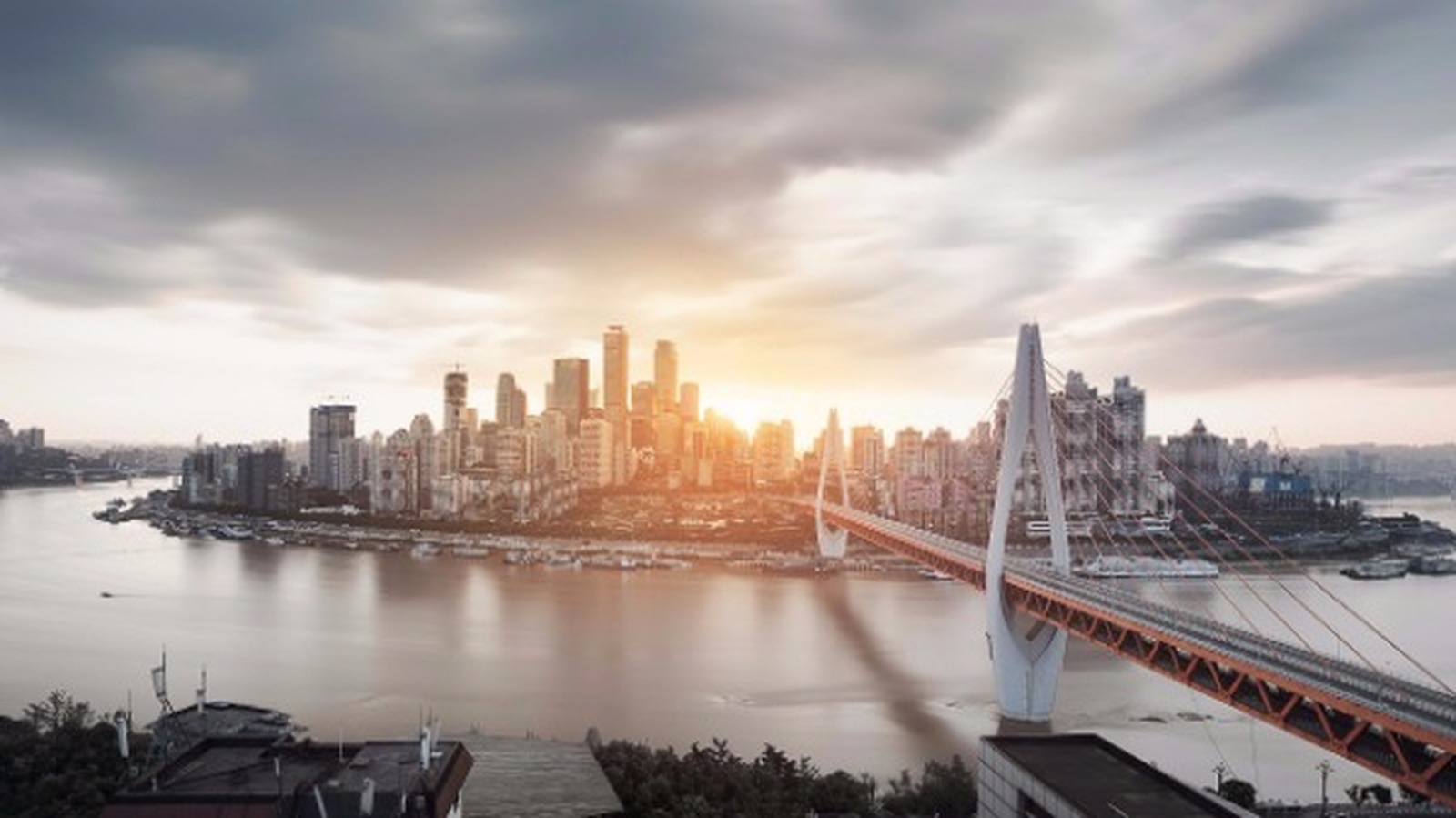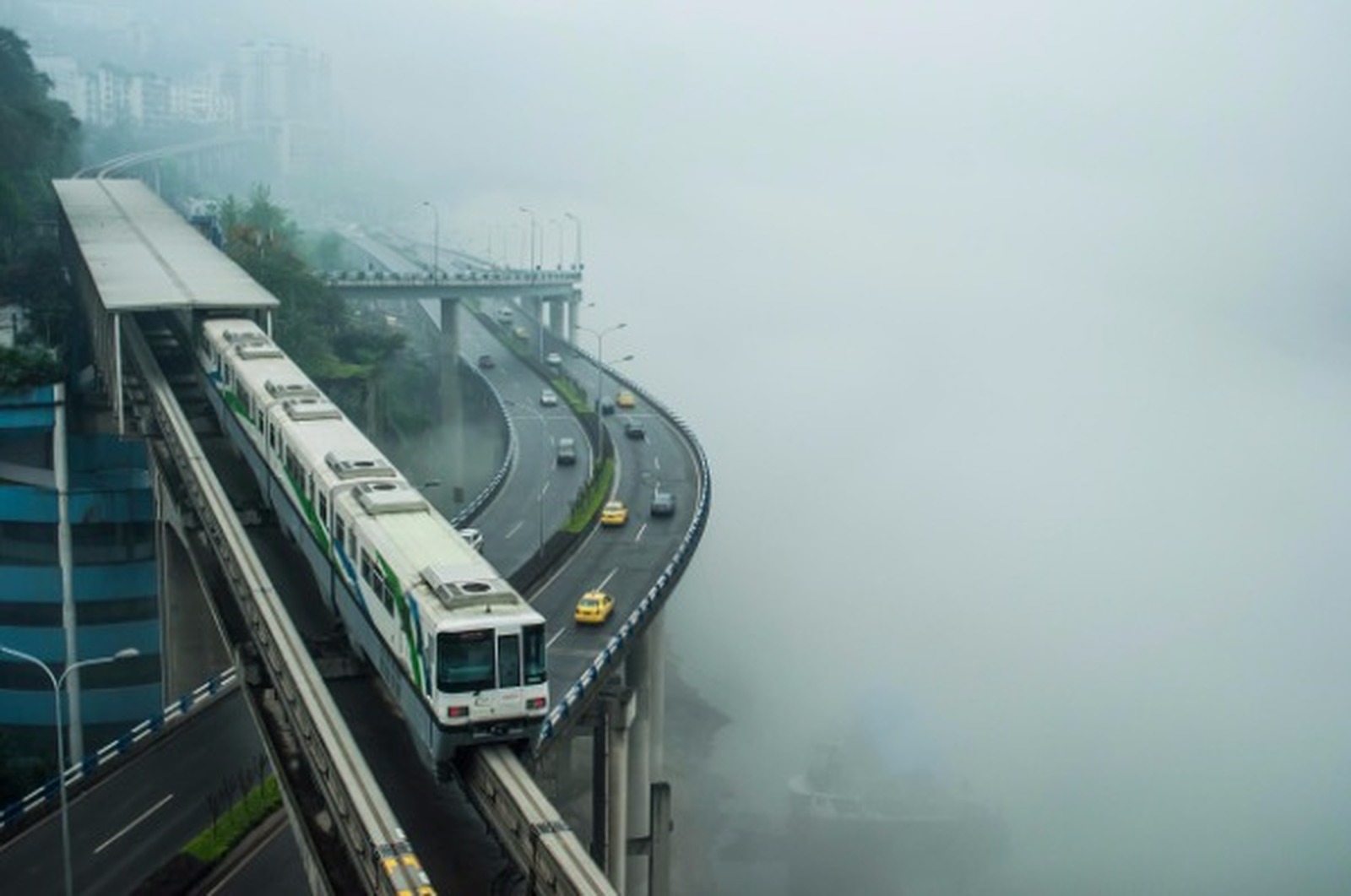Day 1: Old City (Yuzhong Peninsula)
Yuzhong Peninsula, the old city, is where this city began to develop over 3000 years ago. Known as Chongqing's "Mother City", it's full of skyscrapers and a magical atmosphere, perfect for exploring on foot.
Morning: Chaotianmen, Jiefangbei, and Yangtze River Cableway
In the morning, you can visit Chaotianmen Port, literally meaning "Gate Facing Heaven". This is the spectacular confluence of the Jialing River and the Yangtze River (on clear days, you can see the "Mandarin Duck Hotpot" phenomenon). The massive, sail-shaped building near the port, Raffles City, has become a new landmark in Chongqing. Its "world's highest horizontal skyscraper" crystal corridor is worth seeing, with a planned observation deck and an "infinity pool" on the top floor.
Next, head to Jiefangbei (or "Liberation Monument"), located at the busiest intersection in downtown Chongqing. There's a saying that you haven't truly visited Chongqing until you've been to Jiefangbei. It's akin to New York's Times Square or Tokyo's Shibuya, surrounded by giant billboards, high-end shopping malls, and renowned brand retailers, making it Chongqing's fashion hub.
The Yangtze River Cableway is currently the only cross-river cableway still operating in China, a must-visit to experience the unique charm of the mountain city. Built thirty years ago, this 1166-meter-long cableway was once a primary mode of transport for residents; now it offers tourists the best way to overlook the city.
- Tip: It's recommended to buy a round-trip ticket to experience the different river views by day and night. During peak hours (especially holidays and evenings), queue times can be long, so plan your time accordingly.
Afternoon: People's Great Hall, Monorail, and Three Gorges Museum
You can visit the Chongqing People's Great Hall. This magnificent architectural complex, built in 1955, mimics Beijing's Temple of Heaven. In front of the building is People's Square, where many people practice Tai Chi, dance, and sing from morning till night, full of urban vitality, making it a great place to observe the lives of local retirees.
If you want to experience the famous "influencer-favorite" monorail system, you can take Line 2 near Jiefangbei. This line runs along the Jialing River, crossing mountains and valleys, much like a roller coaster. At Liziba Station, you'll witness the incredible sight of a train passing through a residential building, a scene that went viral globally after being uploaded online last year.
In the afternoon, a visit to the Three Gorges Museum is recommended. As a landmark building in Chongqing, it faces the People's Great Hall across the square. This museum is not only China's largest specialized museum but also a public institution dedicated to protecting, educating, and researching the cultural relics and natural environment of Chongqing and the Three Gorges Dam area. The 360-degree panoramic film inside the museum will show you the original natural scenery before the construction of the Three Gorges Dam, which is stunning. With over 170,000 artifacts on display, it's an excellent window into Bashu culture and the history of the Three Gorges.
Evening: Two Rivers Night Cruise
At night, you absolutely don't want to miss the magnificent night view of this "Little Hong Kong". The best way is to take a Two Rivers Night Cruise from Chaotianmen Port, cruising along the Yangtze and Jialing Rivers. The tour lasts about an hour and a half, and you'll see the brilliant spectacle of Hongyadong, the Grand Theater, and the high-rises on both banks illuminated by lights.
- Tip: Remember to dress warmly, as the river wind can be cold.
 Yuzhong Peninsula (Old City) glitters in the sunset, ushering in Chongqing's future. With its diversity and vitality, Chongqing has become one of China's most attractive cities.
Yuzhong Peninsula (Old City) glitters in the sunset, ushering in Chongqing's future. With its diversity and vitality, Chongqing has become one of China's most attractive cities.
Day 2: History and Local Life
Morning: Liangjiang International Film City
Just an hour's drive from the city center lies another side of Chongqing, best explored at Liangjiang International Film City (also known as "Republic of China Street"). It preserves the glorious history of China as the wartime capital during the Anti-Japanese War (1931-1945).
A visit to the Film City is like a journey back in time. Opened in late 2016, it recreates six Chongqing districts from the 1930s, featuring over 220 buildings, along with riverside communities (characterized by wooden houses and docks) and parts of the old city walls from that era.
- Tip: Shops, cafes, and restaurants around the scenic area offer authentic 1930s food and drinks. You can even rent a Republic of China-era costume for a "time-travel" photo opportunity.
Afternoon: Ciqikou Ancient Town
Returning from the Film City in the afternoon, you can relax with a cup of tea in the thousand-year-old Ciqikou Ancient Town. Once an important water and land terminal on the Jialing River, it flourished for a time. Today, it's known for its traditional Southwestern architecture, flagstone streets, small shops, and a dazzling array of snacks.
Here, you can find various handicrafts, taste the famous "Chen Mahua" (fried dough twists, with queues at almost every store), or find a riverside teahouse to sit down and experience the leisurely pace of old Chongqing. There are even unique restaurants on boats.
 Chongqing's monorail system is like a roller coaster, traveling along the Jialing River, through mountains and valleys, and even passing through residential buildings, truly exhilarating.
Chongqing's monorail system is like a roller coaster, traveling along the Jialing River, through mountains and valleys, and even passing through residential buildings, truly exhilarating.
Day 3: Nearby Attractions
Daytime: Dazu Rock Carvings and Lotus Garden
A trip to the Dazu Rock Carvings takes a full day but is absolutely worth it. As one of China's four major Buddhist grottoes, it boasts over a thousand years of history and was listed as a UNESCO World Heritage site in 1999.
The special appeal of the Dazu Rock Carvings lies in their astonishing aesthetic quality, excellent state of preservation, rich diversity of themes (both secular and religious), and the insights they offer into ancient Chinese daily life. Many carvings are brightly colored, vividly narrating religious, moral, and historical stories. If you're interested in Buddhism, Taoism, and Confucianism, or simply wish to admire the pinnacle of ancient art, this is a must-see.
After your spiritual journey, you can dine at Lotus Garden on your way back to the city. Recommended dishes include lotus root-themed foods – soup, pork, and porridge – as well as drinks. This restaurant is built on a lotus lake, offering a serene and unique dining experience.
Evening: Nanshan One Tree and Open-Air Hotpot
After a day of sightseeing, you can head to the most famous tourist attraction on Nanshan Mountain, the "One Tree" observation deck, to experience Chongqing's magnificent panoramic night view. This is a classic spot for observing the Yuzhong Peninsula's "3D nightscape", perfectly showcasing the confluence of the two rivers and the peninsula's outline.
Last but not least, if you can tolerate the local spicy flavors, you should try the open-air hotpot restaurants on the mountain. Enjoying offal and duck intestines hotpot while overlooking the night view from Nanshan is the best way to experience Chongqing's "jianghu spirit" (a blend of local grit and camaraderie).
 Chongqing people's love for hotpot is deeply ingrained; this spicy and delicious delicacy is not only mouth-watering but also greatly uplifts one's mood.
Chongqing people's love for hotpot is deeply ingrained; this spicy and delicious delicacy is not only mouth-watering but also greatly uplifts one's mood.
Food Tips
- Street Food: You can find a variety of street snacks in the "Haochi Street" (Bayi Road) area near Jiefangbei. Mouth-watering options include suanlafen (hot and sour noodles), small tangyuan (glutinous rice balls), and Chongqing xiaomian (spicy noodles). "Huashi Wan Zha Mian" (Flower Market Pea Paste and Minced Meat Noodles) near the JW Marriott Hotel is highly recommended.
- Riverside Restaurants: You can try dining on Nanbin Road, which runs alongside the Yangtze River. There are dozens of upscale restaurants here, offering views of the Yangtze River and the Yuzhong Peninsula. Yuxin Chuan Cai and Yunsheng Restaurant are good choices.
- Authentic Hotpot (Dalong Hotpot): Tucked away in an alley in Shapingba District, there's an unassuming restaurant called "Dalong Hotpot". It's a top choice for true foodies, open until 3 AM. This establishment has been open for at least 20 years, with consistently authentic old-school hotpot flavors.
- High-end Hotpot (Bailoatian Hotpot): If you're looking for a more upscale restaurant with a better ambiance, Bailoatian Hotpot might be for you – it's Chongqing's first known hotpot restaurant, founded in 1921. This newly renovated restaurant, located in downtown Jiefangbei, features 1930s retro-style decor and live bands playing local traditional music.
Recommended Bars
- Niccolo Hotel's Sky Bar: Located next to Raffles City, it's one of Chongqing's highest bars, featuring live bands and excellent views.
- Mr Tipsy Whiskey and Cocktail Bar: Through Hongyadong, an upscale and quiet spot for a drink and river views.
- Regent Hotel's River Terrace: Features great outdoor seating with views of the Jialing River and the city, offering a relaxed atmosphere.













